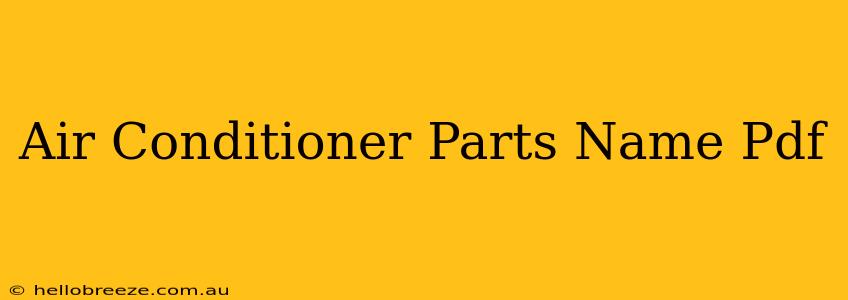Finding a reliable, comprehensive PDF detailing every air conditioner part name can be tricky. While a single, universally accepted PDF doesn't exist, this guide will equip you with the knowledge to identify key components, regardless of your AC unit's brand or model. Understanding these parts is crucial for maintenance, troubleshooting, and repairs.
Key Air Conditioner Components and Their Functions
This section breaks down essential AC parts, explaining their roles in the cooling process. Remember, the exact terminology and arrangement might vary slightly depending on the manufacturer and model.
Outdoor Unit Components:
- Compressor: The heart of the system, the compressor pumps refrigerant throughout the system, raising its pressure and temperature. A malfunctioning compressor often signifies a major problem requiring professional repair.
- Condenser Coil: This outdoor coil releases heat absorbed from the refrigerant into the surrounding air. Dirt and debris can significantly reduce its efficiency; regular cleaning is vital.
- Condenser Fan Motor: This motor drives the fan that blows air across the condenser coil, facilitating heat dissipation. A faulty fan motor can lead to overheating and compressor failure.
- Expansion Valve (or metering device): This regulates the flow of refrigerant from the high-pressure side to the low-pressure side of the system. Proper functioning is key to efficient cooling.
- Refrigerant Lines: These connect the outdoor and indoor units, carrying the refrigerant between them. Leaks in these lines require professional attention and refrigerant recharge.
Indoor Unit Components:
- Evaporator Coil: Located inside the unit, this coil absorbs heat from the indoor air. Just like the condenser coil, keeping it clean is essential for performance.
- Blower Motor: This motor drives the fan that circulates cool air throughout the room. A weak or malfunctioning blower motor will result in poor airflow.
- Air Filter: This traps dust and other particles, preventing them from entering the evaporator coil. Regular filter changes are crucial for maintaining efficiency and indoor air quality.
- Indoor Fan: This fan pushes air over the evaporator coil and distributes the cooled air into the room.
- Drain Pan and Drain Line: These collect condensation produced during the cooling process and drain it away. Clogs in the drain line can cause water to overflow.
Troubleshooting Your AC Unit: Knowing the Parts Helps!
Familiarity with AC components is invaluable for basic troubleshooting. For instance:
- Weak airflow: Check the air filter, blower motor, and for any obstructions blocking airflow.
- No cooling: Check the compressor, condenser fan, and refrigerant levels (this requires professional assessment).
- Water leaks: Inspect the drain pan and drain line for clogs.
Seeking Professional Help: When to Call an Expert
While understanding your AC parts empowers you to perform basic maintenance, some issues require expert attention. Always call a qualified HVAC technician if:
- You suspect a refrigerant leak.
- The compressor is not working.
- You encounter electrical problems.
- You have a complex issue beyond basic troubleshooting.
Remember, safety should always be your priority. Improper handling of AC components can lead to injury or further damage.
Conclusion: Mastering Your Air Conditioner
This guide provides a foundational understanding of common air conditioner parts. Although a comprehensive PDF isn't readily available in a single source, this detailed breakdown allows you to confidently identify and understand the functionality of your system's key elements. Regular maintenance, and knowing when to call a professional, will help extend your air conditioner's lifespan and ensure optimal performance during those hot summer months.

